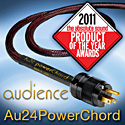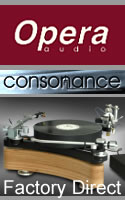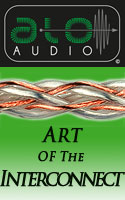|
|
You are reading the older HTML site
Positive Feedback
ISSUE
58
emotiva XPA-2 Amplifier - A True Beauty Comes From Within as reviewed by Tom Gibbs
Earlier this spring I had a little too-close encounter with Mother Nature when a nearby lightning strike nearly took out my entire home theater set-up and seriously crippled my stereo rig, frying my Acurus A-250 power amp and effectively halting my initial foray into a computer-based front end. The PC I was using as a music server was also slightly damaged, and I'd just received the HRT Music Streamer II, so my new primary feed to my heavily modded Magneplanar MMG's was now virtually nonexistent. Fortunately the computer damage was minimal, but in this day and age of disappearing audio salons, just try and find a replacement power amp for under a grand on the spur of the moment. Even here in Atlanta, with a population of five million-plus, where high-end audio shops numbered in the double-digits seemingly only a few years ago—I can only count four, and only one of those offers any kind of decent selection of used gear. Of course, over the next week or so I checked out all the local options—no dice, and frequent trips to Audiogon unfortunately yielded similar results. Which was really bringing me down, because with the recent rebuild of my MMG's crossovers, I was in the midst of a full-on love affair with the A-250 and the thrilling synergy it brought to my system and my enjoyment of the music. It was obviously time for "Plan B." I'd seen some pretty good comments on the Audio Asylum blog (among others) regarding Emotiva amplifiers, and I have to admit that I'd even gone to their website on occasion, particularly fascinated with their model XPA-2. It seemed to offer seriously good build quality, a ton of power into 4 ohms (500 watts per channel minimum!), and was reasonably priced at $799—which included shipping! Although made in China, the design is American, and it didn't take very long for me to reach the realization that I'd probably not in the foreseeable future realistically entertain any ideas of owning an American-made amplifier that offered the kind of heft I'd need to effectively power the notoriously power-hungry Maggies. I took the plunge, and a call to Emotiva got the ball rolling. I realized that Emotiva's headquarters are in Tennessee—which is conveniently adjacent to where I live in Georgia—but I was totally shocked when I checked my email later that evening to discover that delivery was scheduled for the next day! My only real hesitation in the entire process dealt with the occasional online comment regarding the XPA-2's "pedestrian" looks. Remarks in the range of "nondescript," "ugly big square box"—you get the picture. While I've always felt that form and function should go hand-in-hand, I'm infinitely much more concerned with performance, and besides, most amplifier fascias are just thick aluminum face plates with a power switch, right? How ugly could it be? On arrival day, of course—I get called into work, and my wife had a previous appointment, so we missed delivery, which required a signature. I had to go to the local FedEx location to retrieve the amp, and when a young lady who appeared to be roughly five feet tall and maybe 100 pounds soaking wet hoisted it seemingly effortlessly onto the counter, I just about lost it—I already knew the shipping weight was in excess of 89 pounds! Trust me, it took some effort to get the hundred or so yards to my car without having an aneurism or looking like a total nerf—fortunately, I have a hand truck at home, and was able to roll the darn thing around my house to the basement entry where my listening room is located. The unit was double-boxed to perfection, and came with pretty clear extraction instructions to prevent you from injuring yourself while removing it from the rather large box. My initial impression of the appearance of the amp was good—I'd definitely call its utilitarian appearance more in the category of "no frills" than outright ugly! Construction of the amp is top notch, with a thick black aluminum faceplate and silver accent panels along the sides. Removing the top cover reveals impressive construction under the hood; the two rows of heavy aluminum heat sinks frame the shielded compartment that houses the massive toroidal transformer—obviously a major part of the XPA-2's considerable bulk. There's also a massive array of capacitors that total 180,000uF, and 12 output devices per channel, which definitely contribute to the XPA-2's generous headroom. The glass epoxy circuit boards, 1% resistors and metal film capacitors combine to give a jewel-like appearance to the interior that is just beautiful to behold; the Chinese really are producing some remarkable equipment these days, and the construction standards and fit-and-finish are impressive indeed. Were it not for the occasional crumb snatcher or curious kitty in the listening room I'd leave the cover off to more easily be able to admire the build quality. There's a pretty cool looking blue illuminated power switch on the front panel, along with a display panel that includes rows of LEDs for power level and protection status; upon turn on, the LEDs light all red momentarily, then switch to blue. There are two meter level settings, which appear to give peak or average readings, or they can be defeated if that's your preference. Personally, I like the meters; I keep them on the peak level setting, and in nine months I've never once seen the meters light red during use (an indication of the amp being driven to clipping levels), and I've thrown some pretty heavy-duty, demanding stuff of all genres at this beast! "Beast" is definitely the correct choice of words for this monster of an amplifier. The XPA-2 offers both balanced and single-ended input connections; my Acurus preamp doesn't have balanced outputs, so upon initial hookup, I used a pair of 15 year old Audioquest Topaz single-ended cables, which still sound remarkably neutral despite their age. Prior to doing any serious listening, I powered the amp on and let it cook for 24 hours to get good and warm; I was quite pleasantly surprised to find that even after idling overnight, it was still barely warm to the touch. In fact, even after considerably extended listening sessions, the amp still barely warms beyond idle temperature. This is pretty impressive; my old Acurus essentially heated my basement listening room—you could easily use it as a cook top if so desired! The real marvel for me here is that nothing I've fed this amp has fazed it—despite the fact that I mostly listen to a mixture of acoustic jazz, vocals, traditional folk and classical, I still have the occasional hankering for some classic metal—Deep Purple, Black Sabbath, Blue Oyster Cult and the like. A recent session where I hammered out Black Sabbath's classic eponymous first album, Machine Head from Deep Purple and BOC's first three albums—over a period of about five hours and all at SPL peaks in excess of 110 decibels, averaging 100+ decibels—did little to cause any reason for concern with the XPA-2. Tony Iommi's searing, lengthy guitar solo midway through "Warning" is one of the hallmarks of early metal (tell me guys like Kirk Hammett of Metallica weren't listening to this as kids!), and will challenge any amplifier or speaker system to the utmost. The Emotiva never broke a sweat, and always delivered an image that was spacious, deep and above all, musical. Sheer brawn is a department where the XPA-2 is definitely not lacking. But that's not to say the XPA-2 is only comfortable when being driven to near maximum output; it's also quite superb with quieter—but no less demanding—acoustic music. One of my favorite jazz albums is Wynton Marsalis' Levee Low Moan - Soul Gestures in Southern Blue, Vol. 3, the third of a series of albums where Marsalis finally found his own voice, and contains some of his best original music and some of the most superb playing of his career. The album's centerpiece is the ten-minute-long "In The House of Williams," which opens with a really cool bass vamp that builds in intensity as each member of the sextet joins in, soloing furiously throughout, until the tune closes exactly as it opens. The CD was produced by Steve Epstein (whom I had the pleasure to meet recently), and has been in my collection for about 20 years. While I'm all about magnificent sound, I also fully realize that classic performances and great sound don't always coexist in the same recording. And I can honestly say that until the XPA-2 became part of my system, I never really heard this incredible album in its full glory. Each of the players occupies a very real space in the soundstage, and they're presented with a palpable depth and clarity that just about defies belief. All these years, I've been thinking Steve Epstein—woo hoo, producer of Grammy-winning, great recordings that are about as lifeless and two dimensional as they come. Needless to say, I'm thoroughly re-evaluating my thought process towards Mr. Epstein and any of his recordings that are in my collection – the guys a friggin' genius, obviously! A good deal of the credit is in no small part due to the HRT Music Streamer II+ that's currently in my system, which breathes new life into so many of the CDs that I'd essentially given up on as just unfortunate victims of the early digital age. But much of the credit is definitely due to the XPA-2; this amp is the closest thing to a true world-class performer that has ever graced my home system, even outclassing the similarly powered Classé monoblocks from a previous system incarnation, which also included a separate DAC and transport. While the Classé amps were incredible in terms of build quality and appearance (stunning to look at and visually impressive), they just never powered the Magneplanar 2.5 QR's anywhere nearly as satisfyingly as the Emotiva amp drives the MMGs that occupy my current system. And the MMGs are the entry-level Magneplanar, roughly one-third the list price of the 2.5's back in the day. While I have done some work to upgrade the MMGs—custom built stands and greatly enhanced crossovers—we're still talking about a $700 pair of speakers that, powered full-range by the Emotiva XPA-2, will go toe-to-toe with just about anything I've ever heard in terms of imaging and sheer dynamics. Anyone who's ever owned Magneplanars knows how incredibly difficult they can be to drive to satisfying levels; you just don't get by with any old mid-fi junk. The Emotiva came with a thirty day, no-questions return period; I was fully prepared to return the amp if it in any way didn't meet my expectations. What I wasn't prepared for was the totally unexpected leap in performance that came with the XPA-2; I really feel that for the very first time, I'm experiencing world-class performance with you-are-there realism in my system on a daily basis. And the $799 price tag is the real shocker—my Classé amps were priced at about $4000 for the pair! I've been playing all my favorite music just about to death over the last few months, and all the FLACs, LPs, CDs and SACDs that I use as musical frames of reference have taken on so much more meaning and detail—it's been a revelation, to say the least. Emotiva sells everything direct and free shipping is included in the price. If you're looking for superior stereo amplification on a budget, the XPA-2 may very well be the ticket, and they also offer 3- and 5-channel versions, all essentially built on the same chassis. My experience has been so positive, I wouldn't hesitate to buy from Emotiva again. Very highly recommended! Tom Gibbs
XPA-2 Amplifier
Emotiva
|







